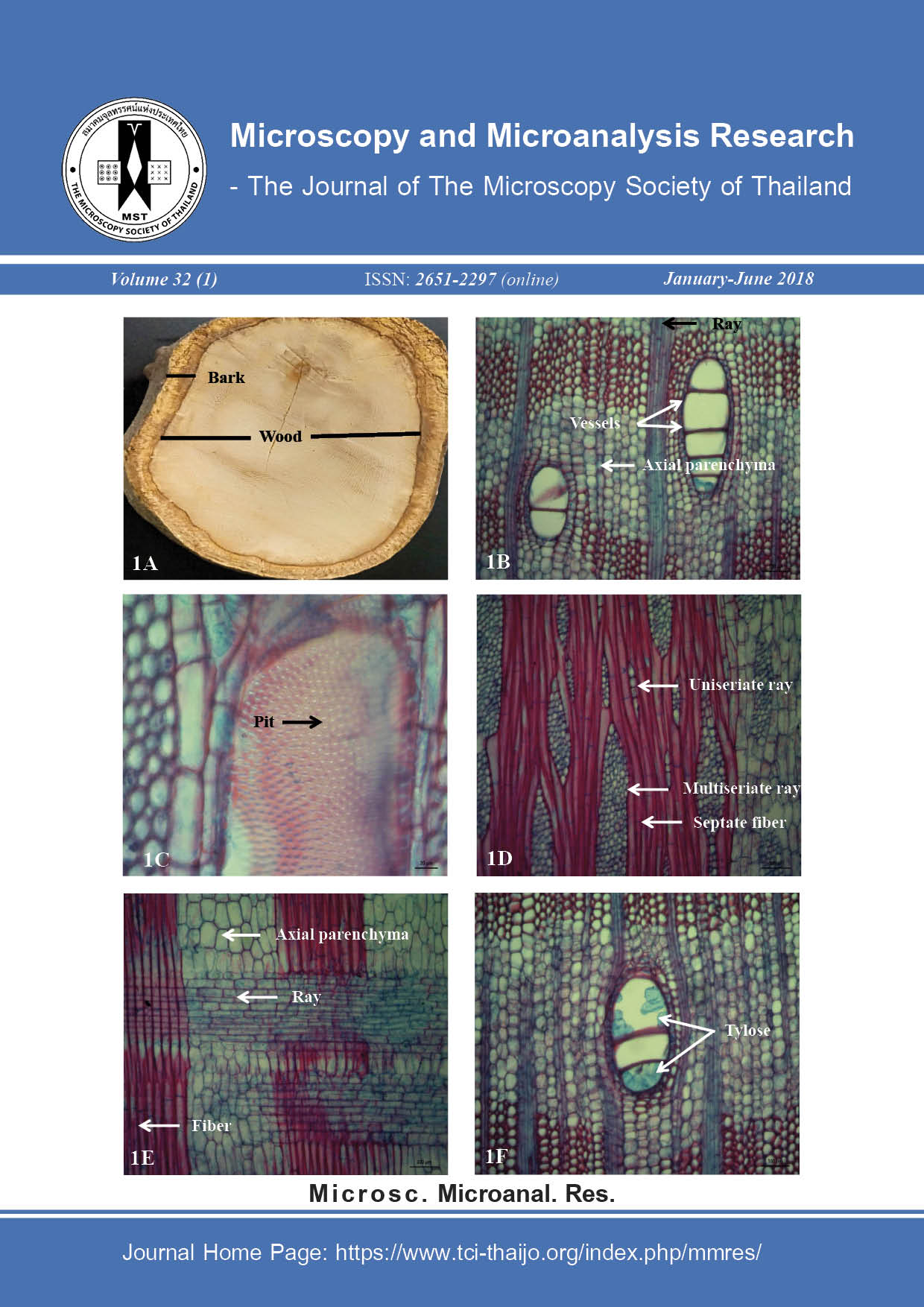Endoparasitic Infection in Threadfin Bream (Nemipterus hexodon and N. japonicus) from Department Store in Chiang Mai Province, Thailand
Main Article Content
Abstract
A survey was undertaken to find endoparasites in ornate threadfin bream (Nemipterus hexodon) and Japanese threadfin bream (N. japonicus) from department store in Chiang Mai province which were originally sent from Chachoengsao province. Fishes were collected from December 2018 to January 2019. A total number of 40 fishes were investigated by using light microscope. Thirty-three fishes were infected by Anisakis sp. third-stage larvae (L3) which has distinctive characteristics such as projecting boring tooth and rounded tail bears a mucron. The prevalence of Anisakis sp. in N. hexodon and N. japonicus was 75 and 90%, respectively. Intensity in N. hexodon and N. japonicus was 4.40 and 5.28 and abundance was 3.30 and 4.75, respectively. Anisakid nematode in third-stage larvae affect a growing number of people in developed countries, which are important endoparasitic nematode causing anisakiasis that make sudden epigastric pain, nausea, vomiting, diarrhea and urticaria in humans who consumed raw or undercooked seafood; for example, sushi and sashimi that are very popular foods in Japan and Thailand. Moreover, it is suspected that N. japonicus were infected by Camallanus sp. and Rhadinorhynchus sp. with 20 and 15% of prevalence that not found in N. hexodon. Based on the results of this study with high prevalence of Anisakis sp. and other infected parasites, strategies to prevent the potential or allergies risks of anisakiasis to consumers were suggested.
Article Details
References
[2] W.M. Cameron, Parasites and Parasitism. Third ed., John Willey & Sons, New York, 1962.
[3] E. Pozio, Integrating animal health surveillance and food safety: the example of Anisakis, Rev. sci. tech. Off. int. Epiz., 2013, 32, 487-496.
[4] S. Shuman, Structure mechanism and evolution of the mRNA capping apparatus, Prog. Nucleic Acid Res. Mol. Biol., 2000, 66, 1-40.
[5] J.A. Sakanari, J.H. McKerrow, Anisakiasis, Clin. Microbiol. Rev., 1989, 2, 278-284.
[6] Y. Nawa, C. Hatz, J. Blum, Sushi delights and parasites: The risk of foodborne and foodborne parasitic zooneses in Asia, Clin. Infect. Dis., 2005, 41, 1297-1303.
[7] V. Hemsrichart, Intestinal anisakiasis: first report case in Thailand, J. Med. Assoc. Thai., 1993, 76, 117-121.
[8] E. C. Faust, P. F. Russell, R. C. Jung, Clinical parasitology, Eighth ed., Lea& Febioger, Philadefphia, 1970.
[9] L.S. Roberts, J. Jonavy, Gerald D. Schmidt & Larry S. Roberts’ foundation of parasitology, Eighth ed., McGraw-Hill, New York, 2009.
[10] J. W. Smith, Anisakis simplex (Rodolphi, 1809, det. Krabbe, 1878) (Nematoda: Ascaridoidea): Morphology and morphometry of larvae from euphausiids and fish, and a review of the life-history and ecology, J. Helminthol., 1983, 57, 205-244.
[11] K.A. Quiazon, T. Yoshinaga, K. Ogawa, R. Yukami, Morphological differences between larvae and in vitro-cultured adults of Anisakis simplex (sensu stricto) and Anisakis pegreffii (Nematoda: Anisakidae), Parasitol. Int., 2008, 57, 483-489.
[12] R. Murata, J. Suzuki, A. Kai, Morphological and molecular characterization of Anisakis larvae (Nematoda: Anisakidae) in Beryx splendens from Japanese waters, Parasitol. Int., 2011, 60, 193-198.
[13] E. Setyobudi, C.H. Jeon, C. Lee, K.B. Seong, J.H. Kim, Occurrence and identification of Anisakis spp. (Nematoda: Anisakidae) isolated from chum salmon (Oncorhynchus keta)
in Korea, Parasitol. Res., 2011, 108, 585-592.
[14] S. Yamagutti, Systema Helminthum volumeIII Nematodes, First ed., Interscience publishers Inc., New York, 1961.
[15] S. Yamagutti, Systema Helminthum volumeV Acantho-cephala, First ed., John Wiley & Sons, Inc., New York, 1963.
[16] C. Nuchjangreed, Z. Hamzah, P. Suntornthiticharoen, P.S. Nuntawarasilp, Anidsakids in marine fish from the coast of Chonburi province, Thailand, Southeast Asian J. Trop. Med. Public Health, 2006, 37(3), 35-39.
[17] E. Abollo, C. Gestal, S. Pascual, Anisakis infestation inmarine fish and cephalopods from Galician waters: anupdated perspective, Parasitol. Res., 2001, 87, 492-499.
[18] E. Stromnes, K. Andersen, Distribution of whaleworm (Anisakis simplex, Nematoda, Ascaridoidea) L3 larvae in three species of marine fish; saithe (Pollachius virens (L.)), cod (Gadus morhua L.) and redfish (Sebastes marinus (L.)) from Norwegian waters, Parasitol. Res., 1998, 84, 281-285.
[19] O.M. Amin, F.M. Nahhas, F. Yamani,R.A. Hakima, On three Acanthocephalan species from some Arabian Gulf fishes off the coast of Kuwait, J. Parasitol., 1984, 70(1), 168-170.
[20] S. Qasim, Z. Ayub, Prevalence and intensity of parasites in edible fishes landing at Karachi Fish Harbour, Pakistan J. Zool., 2012, 44(6), 1467-1471.
[21] O.M. Amin, R.A. Heckmann, A.H. Ali, The finding of Pacific transvenid acanthocephalan in the Arabian Gulf, with the description of Paratrajectura longcementglandatus n. gen., n. sp. from perciform fishes and emendation of Transvenidae, J. Parasitol., 2018, 104(1), 39-50.
[22] A. Nematollahi, P. Shahbazi, M.F. Abbasi, S. Ghaemaghami, I. Mobedi, The first report of Nematode (Contracaecum) and two Acanthocephala (Serrasentis sagittifer, Tenuiosentis niloticus) in Persian Gulf’s japanese threadfin bream (Nemipterus japonicus), Comp. Clin. Path., 2013, 22(5).
[23] F. Moravec, J.L. Justine, M.C. Rigby, Some camallanid nematodes from marine perciform fishes off New Caledonia, Folia Parasitol., 2006, 53, 223-239.
[24] W. Pakdee, T. Yeemin, S. Sa-ngunkiet, S. Chullasorn, M. Sutthacheep, Comparison of helminth fauna from three different habitats in the Andaman Sea coastal ecosystem, southern Thailand, ANRES, 2018, 52, 176-181.
[25] O.M. Amin, Classification of the Acanthocephala, Folia Parasitol., 2013, 60(4), 273-305.
[26] L.R. Smales, The genus Rhadinorhynchus (Acanthocephala: Rhadinorhynchidae) from marine fish in Australia with the description of four new species, Acta Parasitol., 2014, 59(4), 721-736.
[27] O.M. Amin, R.A. Heckmann, Rhadinorhynchus oligospino-sus n. sp. (Acanthocephala, Rhadinorhynchidae) from mackerels in the Pacific Ocean off Peru and related rhadinorhynchids in the Pacific, with notes on metal analysis, Parasite, 2017, 24, 1-12.


